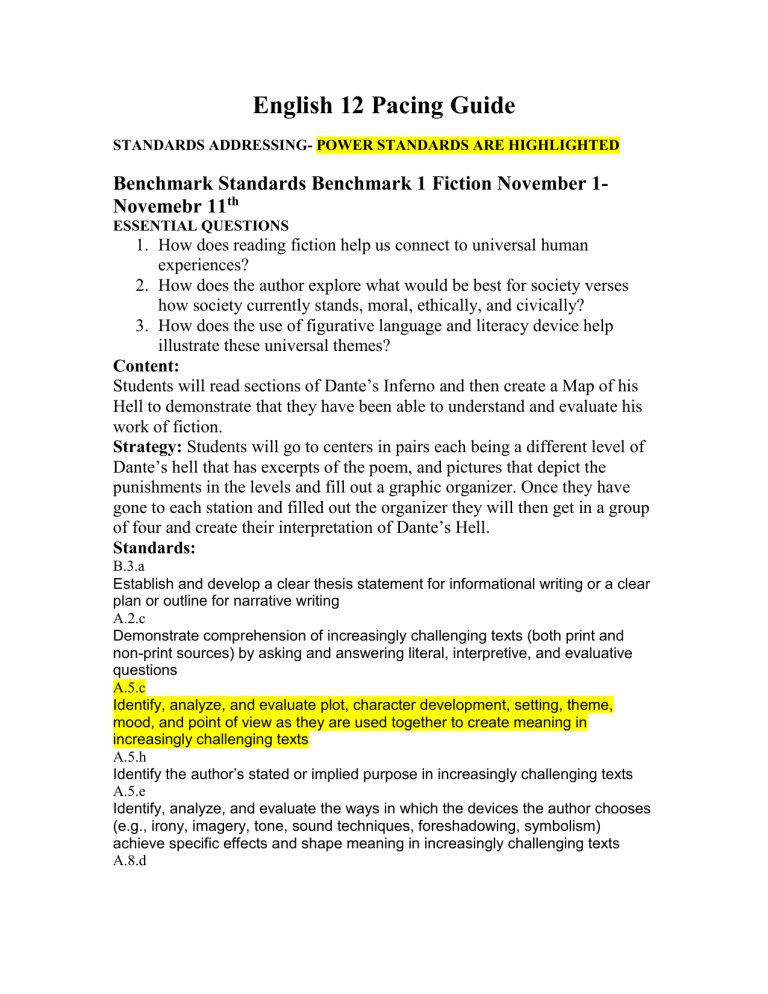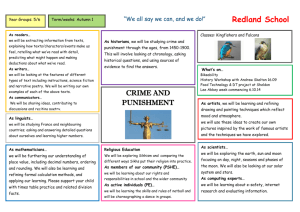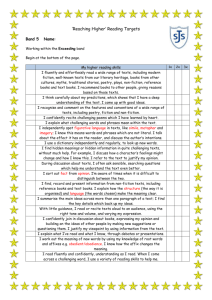Content - Carroll County Schools

English 12 Pacing Guide
STANDARDS ADDRESSING- POWER STANDARDS ARE HIGHLIGHTED
Benchmark Standards Benchmark 1 Fiction November 1-
Novemebr 11
th
ESSENTIAL QUESTIONS
1.
How does reading fiction help us connect to universal human experiences?
2.
How does the author explore what would be best for society verses how society currently stands, moral, ethically, and civically?
3.
How does the use of figurative language and literacy device help illustrate these universal themes?
Content:
Students will read sections of Dante’s Inferno and then create a Map of his
Hell to demonstrate that they have been able to understand and evaluate his work of fiction.
Strategy: Students will go to centers in pairs each being a different level of
Dante’s hell that has excerpts of the poem, and pictures that depict the punishments in the levels and fill out a graphic organizer. Once they have gone to each station and filled out the organizer they will then get in a group of four and create their interpretation of Dante’s Hell.
Standards:
B.3.a
Establish and develop a clear thesis statement for informational writing or a clear plan or outline for narrative writing
A.2.c
Demonstrate comprehension of increasingly challenging texts (both print and non-print sources) by asking and answering literal, interpretive, and evaluative questions
A.5.c
Identify, analyze, and evaluate plot, character development, setting, theme, mood, and point of view as they are used together to create meaning in increasingly challenging texts
A.5.h
Identify the author’s stated or implied purpose in increasingly challenging texts
A.5.e
Identify, analyze, and evaluate the ways in which the devices the author chooses
(e.g., irony, imagery, tone, sound techniques, foreshadowing, symbolism) achieve specific effects and shape meaning in increasingly challenging texts
A.8.d
Use context clues (e.g., author’s restatement, example) to understand unfamiliar words in increasingly challenging texts
B.6.b
Use punctuation correctly within sentences and words
A.2.d
Use close-reading strategies (e.g., visualizing, annotating, questioning) in order to interpret increasingly challenging texts
B.3.e
Write an introduction that engages the reader and a conclusion that summarizes, extends, or elaborates points or ideas in the writing
A.6.c
Locate important details and facts that support ideas, arguments, or inferences in increasingly challenging texts and substantiate analyses with textual examples that may be in widely separated sections of the text or in other sources
A.6.b
Summarize and paraphrase information in increasingly challenging texts, identifying key ideas, supporting details, inconsistencies, and ambiguities
C.C.
Evaluate multiple sources of information for accuracy, credibility, currency, utility, relevance, reliability, and perspective
A.8.h
Apply knowledge of connotation and denotation to determine the meanings of words and phrases in increasingly challenging texts
A.5.c
Identify, analyze, and evaluate plot, character development, setting, theme, mood, and point of view as they are used together to create meaning in increasingly challenging texts
B.5.d
Make subject and verb agree in number, even when a phrase or clause between the two suggests a different number for the verb
Writing of Fiction November 9 th -11th
Content: Dante’s Inferno/Flannery O’Conner
“What Dreams may come”-Film clips
Strategy Students will write an essay that will compare and contrast the video clips from the film “What dreams may come” to Dante’s poem the Inferno.
B.3.A
Establish and develop a clear thesis statement for informational writing or a clear plan or outline for narrative writing
B.4.A
Recognize and correct errors that weaken writing, including nonparallel structure, shifts from active to passive voice, misused modifiers, and awkward sentence construction
B.4.G
Use strong action verbs, sensory details, vivid imagery, and precise words
English 12 – Benchmark 2 – Nonfiction November 14-
December 16th
Essential Questions
1.
How do use of rhetorical devices help build convincing arguments?
2.
How and why does parallel structure make and argument more convincing?
3.
How does using a variety of appeals (logos, ethos, and pathos), help the audience access the argument?
Content: Reading informational texts. Students will read a variety of informational texts on many real-world situations and be able to evaluate the readings on many cognitive levels, such as being able to identify, analyze and evaluate the author choses of his/her arguments.
Strategy: Provide students with a controversial article prompting students if they know the articles purpose to persuade or to inform? Then briefly discuss the descriptors of an article, that is has a title and a byline and it usually isn’t written in 1 st person. Provide examples of editorial or letter to the editor, can be printed or video. Compare and contrast discussion about the differences between the editorial, letter to the editorial, or article. Also, begin discussion of appeals: logos, ethos, and pathos. Begin collaborative group work to identify where these different appeals are being used in the example pieces.
Formative assessments- Characteristics on different article types- Exit slip, vin diagram, quiz.
Standards:
A.5.H
Identify the author’s stated or implied purpose in increasingly challenging texts
A.5.E
Identify, analyze, and evaluate the ways in which the devices the author chooses
(e.g., irony, imagery, tone, sound techniques, foreshadowing, symbolism) achieve specific effects and shape meaning in increasingly challenging texts
A.6.C
Locate important details and facts that support ideas, arguments, or inferences in increasingly challenging texts and substantiate analyses with textual examples that may be in widely separated sections of the text or in other sources
C.C.
Evaluate multiple sources of information for accuracy, credibility, currency, utility, relevance, reliability, and perspective
A.6.B
Summarize and paraphrase information in increasingly challenging texts, identifying key ideas, supporting details, inconsistencies, and ambiguities
A.8.H
Apply knowledge of connotation and denotation to determine the meanings of words and phrases in increasingly challenging texts
A.5.A
Critique the effectiveness of the organizational pattern (e.g., comparison/contrast, cause/effect, problem/solution) and how clarity of meaning is affected by the writer’s techniques (e.g., repetition of ideas, syntax, word choice) in increasingly challenging texts
Nonfiction Writing November 21st-December 16
th
Content:
Students will master the elements of persuasion and rhetoric
Use of quotes (ethos appeal)
Use of statistics (Logos appeal)
Use of anecdote ( pathos appeal)
Topic- claim, refuting, defending, and qualifying thesis statement
Conclusion- restate and connect to higher universal issue
Support- Identifies appoints support reasons and refutes them
Students will use strong action verbs, sensory details, vivid imagery, and precise words in their topic, conclusion, and support
Student will use peer evaluation rubrics to identify key elements of genre and use as a guideline for final drafts
Strategy:
Summarizing note taking
Identifying similarities and differences
Corporative learning
Non-linguistic representations
Homework and practice
Ques questions and advanced organizers
Standards:
B.3.E
Write an introduction that engages the reader and a conclusion that summarizes, extends, or elaborates points or ideas in the writing
B.4.G
Use strong action verbs, sensory details, vivid imagery, and precise words
B.6.B
Use punctuation correctly within sentences and words
B.2.B
Craft first and final drafts of informational essays or reports that provide clear and accurate perspectives on the subject; support the main ideas with facts, details, and examples; and make distinctions about the relative value and significance of those facts, details, and examples
B.3.B
Organize writing to create a coherent whole with effective, fully developed paragraphs, similar ideas grouped together for unity, and paragraphs arranged in a logical sequence
English 12 – Benchmark 3 – Poetry March 5
th
-16
th
Essential Questions
1.
How does poetry allow for universal expression of emotions?
2.
How does the use of figurative language and sensory details add to the illustration of universal themes?
3.
How does syntax, structure, affect how a poem is perceived?
Content:
Students will read/listen to poetry by Dylan Thomas, as well as songs written by Bob Dylan. Students will be given a song by Bob Dylan in paper form and evaluate and analyze it as a class, interpreting what each section is about. Students will be able to determine the authors purpose is and meaning of the work and the writer’s use of words to convey a hidden meaning/s.
Students will also view various forms of poetry to help facilitate them in writing their own piece of poetry such as: haiku, limericks, free verse, sonnets, ballads, and odes.
Strategy:
Students will complete the “Dylan/Dylan contest”. Student will have to read, evaluate, and analyze poetry and music by both Dylan Thomas and Bob Dylan to determine the similarities in both areas.
Corporative learning-Students with small groups will find a poem written by Dylan Thomas that is like a song written by Bob Dylan
Non-linguistic representations- Students will listen to and read music by Bob Dylan to master interpretations of the work to find and analyze poetry by Dylan Thomas.
A.5.C
Identify, analyze, and evaluate plot, character development, setting, theme, mood, and point of view as they are used together to create meaning in increasingly challenging texts
A.5.E
Identify, analyze, and evaluate the ways in which the devices the author chooses
(e.g., irony, imagery, tone, sound techniques, foreshadowing, symbolism) achieve specific effects and shape meaning in increasingly challenging texts
A.8.H
Apply knowledge of connotation and denotation to determine the meanings of words and phrases in increasingly challenging texts
A.5.H
Identify the author’s stated or implied purpose in increasingly challenging texts
A.6.C
Locate important details and facts that support ideas, arguments, or inferences in increasingly challenging texts and substantiate analyses with textual examples that may be in widely separated sections of the text or in other sources
A.8.B
Infer word meanings by analyzing relationships between words (e.g., synonyms, antonyms, metaphors, analogies) in increasingly challenging texts
A.2.C
Demonstrate comprehension of increasingly challenging texts (both print and non-print sources) by asking and answering literal, interpretive, and evaluative questions
A.8.D
Use context clues (e.g., author’s restatement, example) to understand unfamiliar words in increasingly challenging texts
A.5.G
Evaluate ways authors develop style to achieve specific rhetorical and aesthetic purposes, noting the impact of diction and figurative language on tone, mood, and theme; cite specific examples from increasingly challenging texts
A.6.B
Summarize and paraphrase information in increasingly challenging texts, identifying key ideas, supporting details, inconsistencies, and ambiguities
Poetry Writing
Content: Students will create an original piece of poetry in any form they would like: that we have talked about in class haiku, limericks, free verse, sonnet, ballads, and odes.
Strategy: Students will be shown various types of poetry from various writers and complete activates meant to help create inspiration and then they will be prompted to write a piece of their own original poetry. Students will use various degrees of figurative language and literary devices that will facilitate this.
B.2.A.
Craft first and final drafts of expressive, reflective, or creative texts (e.g., poetry, scripts) that use a range of literary devices (e.g., figurative language, sound devices, stage directions) to convey a specific effect
B.4.G
Use strong action verbs, sensory details, vivid imagery, and precise word
English 12 Benchmark 4 – Drama March 19
th
-30
th
Essential Questions
1.
Why are certain story line archetypes repeated time after time within plays, movies, and television?
2.
How does dialogue influence our perception of characters?
3.
How does plot structure influence the development of universal theme?
Content:
“ Raisin in the Sun”
Structural Elements
Plot and theme
Dialogue- How create tone and develops irony
Paraphrasing using archetype analysis
Strategy:
Identify similarities and differences comparing works previously read.
Corporative learning-Identify central themes ironies and ambiguities and what techniques are used to build the afore mentioned.
Homework and practice
Summarizing and note taking (annotation)
A.8.H
Apply knowledge of connotation and denotation to determine the meanings of words and phrases in increasingly challenging texts
A.5.E
Identify, analyze, and evaluate the ways in which the devices the author chooses
(e.g., irony, imagery, tone, sound techniques, foreshadowing, symbolism) achieve specific effects and shape meaning in increasingly challenging texts
A.5.C
Identify, analyze, and evaluate plot, character development, setting, theme, mood, and point of view as they are used together to create meaning in increasingly challenging texts
A.6.C
Locate important details and facts that support ideas, arguments, or inferences in increasingly challenging texts and substantiate analyses with textual examples that may be in widely separated sections of the text or in other sources
A.5.B
Recognize an author’s choice of narration and evaluate the overall impact of that choice in increasingly challenging texts
A.6.B
Summarize and paraphrase information in increasingly challenging texts, identifying key ideas, supporting details, inconsistencies, and ambiguities
Drama Writing
Content/Strategy:
Students will create screenplay
Students will produce/ create IMovie of written screen play or animation
Peer rubric- Students will peer edit screenplays based on peer edit rubric
Standards:
B.2.A.
Craft first and final drafts of expressive, reflective, or creative texts (e.g., poetry, scripts) that use a range of literary devices (e.g., figurative language, sound devices, stage directions) to convey a specific effect
B.3.E
Write an introduction that engages the reader and a conclusion that summarizes, extends, or elaborates points or ideas in the writing
English 12 –Benchmark 5 – Essay: Writing to Explain
Essential Questions
1.
Why and how has the essay survived as a reflection of culture?
2.
What is the purpose and audience of essay writing?
3.
What are some common themes in the classic essays of western culture?
Content:
American Classics Essay- Essays by famous Americans or about
American way of life
Identify similarities and differences
Discuss various themes
Discuss how arguments and or persuasion are constructed.
Strategy:
Students will produce an essay on the American Dream
Open form discussion of America’s challenges, that immediately face our society
Discuss in groups of four or five major problems and challenges that society face
Group share on white board
Classify or categorize into general categories
Discuss and identify general problems that are inter-related
Students will be regroup according to which problems that they want to address in their essay then they will discuss proposed solutions as a pre-write strategy for their essay.
B.1.C
Create and use various tools (e.g., rubrics, checklists, models, writing conferences) to revise, refine, edit, and proofread own and others’ writing, using appropriate rhetorical, logical, and stylistic criteria for assessing the final versions of compositions
B.6.B
Use punctuation correctly within sentences and words
B.3.A.
Establish and develop a clear thesis statement for informational writing or a clear plan or outline for narrative writing
B.3.B
Organize writing to create a coherent whole with effective, fully developed paragraphs, similar ideas grouped together for unity, and paragraphs arranged in a logical sequence
B.4.B
Organize writing to create a coherent whole with effective, fully developed paragraphs, similar ideas grouped together for unity, and paragraphs arranged in a logical sequence








